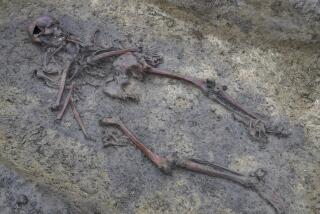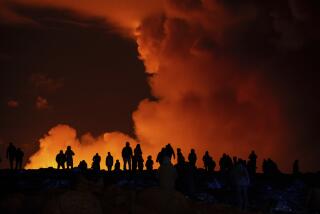Home May Prove Viking ‘Sagas’
- Share via
A UCLA team has apparently found the Iceland home of Snorri Thorfinnsson, the first person of European descent born in the New World.
Icelandic sagas from the 13th century tell the story of how Snorri’s parents led the first Scandinavian group that attempted to settle in Vinland--on the Canadian coast--about AD 1000.
The attempt failed and the family moved to Iceland, but Snorri was born while they were in North America.
The “Vinland Sagas,” which also tell the story of Leif Ericson, are the earliest recorded history of the Scandinavian people, but there has long been a debate over whether they represent real events or are simply an allegorical tale meant to deliver a moral message.
The 1960 discovery of Viking settlements at L’Anse aux Meadows in Newfoundland provided some confirmation of the sagas. The apparent discovery of Snorri’s home provides more.
“These sagas were written in Iceland, and they must have been thinking about this site,” said UCLA archeologist John Steinberg, who led the expedition. “Could this specific story [in the saga] be true? This site may well hold the answers.”
Archeologist Kevin P. Smith of Hunter College in New York City added: “This is a fairly large, fairly well-appointed house. It’s in the right place, from the right time. It may well be” Snorri’s home.
The sagas tell the story of four Viking voyages to the New World. The second saga recounts the story of the pagan Thorfinn Karlsefni, who married the converted Christian woman Gudrid Thorbjarnardottir. With three boats containing 60 to 70 people, livestock, seeds and other supplies, they left for the New World about AD 1000 to establish a colony.
According to the sagas: “Karlsefni’s son Snorri was born [in Vinland] the first autumn and was 3 years old when they left.”
“Conflict with the native population made the settlement impossible,” Smith said, and they returned to Iceland, where they established a farm called Glaumbaer. Thorfinn sailed to Norway and sold a boatload of goods from Vinland, becoming relatively rich in the process.
Gudrid, described in the sagas as “the most attractive of women and one to be reckoned with in all her dealings,” made one or more trips between Iceland and Greenland and eventually traveled to Rome to meet the pope. She became a nun and returned to Iceland, where she established a church. “She was probably one of the most well-traveled women of the period--and all of it in an open boat,” said historian Elisabeth Ward of the Smithsonian Institution’s Museum of Natural History.
The family played a major role in the traveling Smithsonian exhibit, “Vikings: The North Atlantic Saga,” which recently came to Los Angeles.
Steinberg’s continuing project in Iceland is a survey of 26 farms in five areas of the Skagafjordur fiord valley in northern Iceland. This region, he said, “is one of the few documented chiefdoms” that are known. His ultimate goal is to understand how the chiefdoms, in which private properties’ rights were enforced without a central government, eventually gave way to regional rule. His approach is to determine how settlement patterns changed.
But archeology is difficult in Iceland, an island about the size of Kentucky. There are virtually no trees, so buildings were constructed from turf. The inhabitants also severely abused their environment. “They put way too many sheep on the land, and all the soil from the highlands eventually blew onto the coastal regions,” Steinberg said. “As a result, the archeology is invisible, especially in the most important areas.”
The UCLA team has been surveying the region with sophisticated equipment that measures the electrical conductivity and resistance of soil. The turf used in construction has a much lower conductivity, so electrical patterns reveal where walls are located.
They found what they believe to be Snorri’s home about 150 yards east of the Glaumbaer Folk Museum, just outside the seaside village of Saudarkrokur. The museum, which documents 18th century rural Icelandic life, was once thought to have been built on the site of Snorri’s home.
“We had always assumed that the original house must be under the standing modern turf house, in the very same spot and therefore mostly destroyed,” said Sigridur Sigurardottir, the museum’s director. “But now we have found out that it was in our museum hay field all along, just under the surface.”
The building is “a classic German fortress longhouse like the Great Hall of Beowulf,” Steinberg said. It is 95 feet long--about 50% longer than Viking longhouses in Newfoundland and Trelleborg, Denmark, indicating prosperity--and about 30 feet wide, with 5-foot-thick walls. A thick floor of ash and trampled clay was found at the house’s center, about 85 feet long by 5 feet 7 inches wide. Six-foot-wide raised sleeping benches line both sides of the building.
A thin layer of volcanic ash from the 1104 eruption of Mt. Hekla covers the remains, indicating that the structure was abandoned about 1100, when the residents moved up the hill to what is now the site of the museum. Excavations in a garbage pit outside the museum show that the site has since been continuously occupied, Steinberg said.
The team has found few artifacts at the site, but they have not excavated much of the building yet. There are also several smaller outbuildings around the main structure, which they also have not begun to study.
The team will spend another five years excavating the site. “What we are hoping for are artifacts from North America or Rome,” Ward said. “One would think she [Thorbjarnardottir] brought something home with her. We are keeping our fingers crossed that it survived. “
More to Read
Sign up for Essential California
The most important California stories and recommendations in your inbox every morning.
You may occasionally receive promotional content from the Los Angeles Times.













